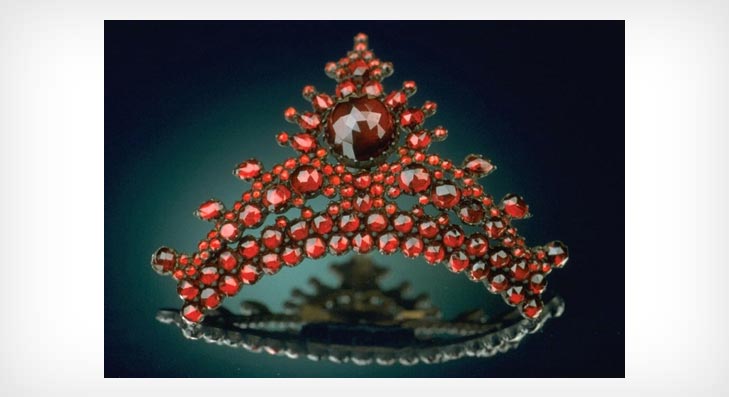Happy Birthday January! We begin our famous birthstone series with none other than January’s birthstone: garnet. While there are many different species, varieties and colours of garnet, perhaps the most well-known is the pyrope garnet. Usually a deep red, this gem is featured in this antique piece, a stunning and historic example of the pyrope’s beauty. and GIA’s famous birthstone for January babies.
“Antique hair comb set with Bohemian pyrope garnets from the Czech Republic. Courtesy Chip Clark, Smithsonian Institution.”
Garnets are a set of closely related minerals that form a group, resulting in gemstones in almost every color. Red garnets have a long history, but modern gem buyers can pick from a rich palette of garnet colors: greens, oranges, pinkish oranges, deeply saturated purplish reds, and even some blues.
Red garnets have a long history, but modern gem buyers can pick from a rich palette of garnet colours: greens, oranges, pinkish oranges, deeply saturated purplish reds, and even some blues. Red garnet is one of the most common and widespread of gems. But not all garnets are as abundant as the red ones. A green garnet, tsavorite, is rarer and needs rarer rock chemistries and conditions to form.
Garnets are a set of closely related minerals that form a group, resulting in gemstones in almost every colour. Red garnets have a long history, but modern gem buyers can pick from a rich palette of garnet colours: greens, oranges, pinkish oranges, deeply saturated purplish reds, and even some blues.
Red garnet is one of the most common and widespread of gems, found in metamorphic rocks (which are rocks altered by heat and pressure) on every continent. But not all garnets are as abundant as the red ones. A green garnet, tsavorite, also occurs in metamorphic rocks, but it’s rarer because it needs unusual rock chemistries and special conditions to form.
Demantoid is a rare and famous green garnet, spessartine (also called spessartite) is an orange garnet, and rhodolite is a beautiful purple-red garnet. Garnets can even exhibit the colour-change phenomenon similar to the rare gemstone alexandrite.
All garnets have essentially the same crystal structure, but they vary in chemical composition. There are more than twenty garnet categories, called species, but only five are commercially important as gems. Those five are pyrope, almandine (also called almandite), spessartine, grossular (grossularite), and andradite. A sixth, uvarovite, is a green garnet that usually occurs as crystals too small to cut. It’s sometimes set as clusters in jewellery. Many garnets are chemical mixtures of two or more garnet species.
Thousands of years ago, red garnet necklaces adorned the necks of Egypt’s pharaohs and were entombed with their mummified corpses as prized possessions for the afterlife. In ancient Rome, signet rings with carved garnets were used to stamp the wax that secured important documents.
The term carbuncle was often used in ancient times to refer to red garnets, although it was used for almost any red stone. Carbuncle was thought to be one of the four precious stones given to King Solomon by God.
Centuries later, in Roman scholar Pliny’s time (23 to 79 AD), red garnets were among the most widely traded gems. In the Middle Ages (about 475 to 1450 AD), red garnet was favoured by clergy and nobility.
Red garnet’s availability increased with the discovery of the famous Bohemian garnet deposits in central Europe around 1500. This source became the nucleus of a regional jewellery industry that reached its peak in the late 1800s.






